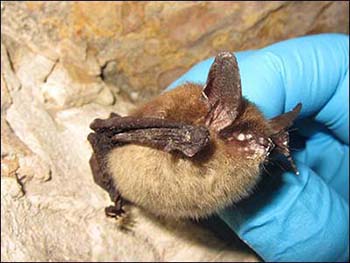This article is from law firm Spencer Fane Britt & Browne.
At a national conference on the Endangered Species Act (ESA) in San Francisco September 2014, a major topic of discussion was the recent settlement agreement that ended litigation between the U.S. Fish and Wildlife Service (“the Service”) and two major environmental groups. The settlement is noteworthy because it requires the Service to take action over the next few years to determine whether to list an additional 251 species. As of May 2014, the Service had listed 97 of these species.

Listing the northern long-eared bat as “endangered” will affect a large part of the country because the bat’s range includes 38 states.
One species that will be listed pursuant to the settlement agreement is the northern long-eared bat. The listing of the bat as “endangered” will affect a large part of the country because the bat’s range includes 38 states: Alabama, Arkansas, Connecticut, Delaware, Florida, Georgia, Illinois, Indiana, Iowa, Kansas, Kentucky, Louisiana, Maine, Maryland, Massachusetts, Michigan, Minnesota, Mississippi, Missouri, Montana, Nebraska, New Hampshire, New Jersey, New York, North Carolina, North Dakota, Ohio, Oklahoma, Pennsylvania, Rhode Island, South Carolina, South Dakota, Tennessee, Vermont, Virginia, West Virginia, Wisconsin, and Wyoming.
Once the bat is listed, the ESA provides it with substantial protections. The ESA prohibits anyone from undertaking any activity that will “harass, harm, pursue, hunt, shoot, wound, kill, trap or capture” a listed species. The ESA also prohibits any modification or destruction of habitat that will injure the species “by significantly impairing essential behavioral patterns, including breeding, feeding or sheltering.”
The listing of the northern long-eared bat will have a substantial impact on certain commercial activities. In the proposal for listing, the Service stated that a primary reason for listing the bat was “the present or threatened destruction, modification, or curtailment of the species habitat or range”. The Service then labeled timber harvesting, wind energy, and natural gas development as significant factors in the reduction of habitat that led to the listing of the species in the first place.
Therefore, once the bat is listed, we expect that the Service will try to limit the impacts on habitat of those particular commercial activities. For example, we expect that if a natural gas development causes habitat loss due to forest clearing for well pads and associated infrastructure, the development will have to implement commensurate conservation measures and possibly obtain a “take” permit before the project can move forward. We also expect that the new ESA protections might be used as a weapon by interest groups that are interested in stopping the development altogether.
We are continuing to watch what is going on in this area. The Service published a “Listing Work Plan” that includes its scheduling commitments for all listing actions required by the recent settlement agreement. According to that schedule, listings of additional species will occur over the next several months. We recommend that proponents of affected commercial activities consult with an expert in the ESA regulatory requirements before conducting any land clearing activities in areas suspected of being listed species habitat.
Spencer Fane Britt & Browne
www.spencerfane.com
Filed Under: News, Policy





Bats echo-locate, are sensitive to wind turbulence, and are very maneuverable around rapidly shifting objects in high winds.
Wind operators need to be proactive in protecting these creatures with sonic diversion experiments and data collection on the activities of all protected species at wind sites (proposed or existing).